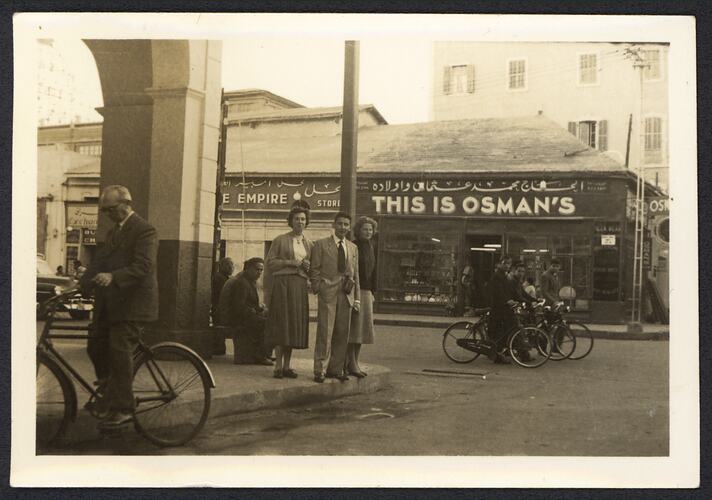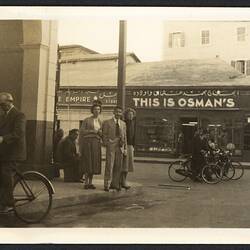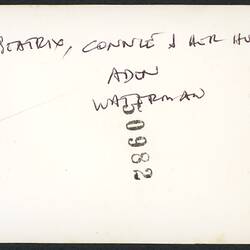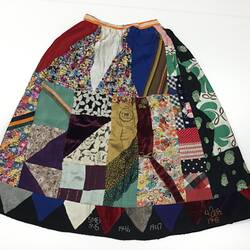Summary
Digital black and white photograph from a photographic print of Tine Roelie Beatrix Gravemaker (standing third from right) with friends Connie and her husband during port stop in Aden during their migrant voyage onboard the SS Waterman from the Netherlands to Australia, 1956.
This is one of nine photographs which relate to the Dutch Gravemaker family and their 'national feestrok' dating to the immediate post-World War II period.
Tine Roelie Beatrix Gravemaker migrated to Australia in 1956, married an Australian in 1959 and went to London with her husband where they worked and had two children. During a visit to family in The Netherlands between 1960-64, Tine was gifted a feestrok skirt made by her grandmother Trijnje Gravemaker-Van Bladeren on her farm in Halfweg, The Netherlands circa 1945-48 (also received were a rosette and four associated documents, all also in the Museum's collection). Tine brought the items with her when the family returned to Australia in 1964, and she obtained Australian citizenship in 1965. The family lived in many locations, including Sydney, Melbourne and Adelaide, and Tine and her husband finally retired in Melbourne.
Physical Description
Digital black and white photograph copied from a photographic print
Significance
The tradition of the 'feestrok (celebration)' skirt is of enormous cultural significance in The Netherlands and to the Dutch people. The idea for the skirt was evolved by Dutch resistence member Mies Boissevain-Van Lennep, inspired by her wartime experiences when imprisoned in a concentration camp and receiving a patchwork garment made by friends. The patchwork nature of the skirt was developed by a committee of Dutch women to symbolise the rebuilding of post War Netherlands. In 1947 the feestrok project was set in motion in conjunction with the International Information Centre and Archives for the Women's Movement.
The commemorative skirt had to meet certain conditions in order to be formerly registered as a 'feestrok' skirt: the use of repurposed multi-coloured and patterned fabric with a hem of even-sized triangles with the date 5 May 1945 and all the subsequent years of national holidays. The skirt was both a national symbol or reconstruction and renewal, but also the personal experiences and meories of the maker. A skirt would be submitted for registration to one of the 'rokkencomites (in Amsterdam and also set up in other towns) where it was assessed for authenticity, stamped as authentic and assigned a registration number and a card of registration sent. The stamp reads: 'Nationale Feestrok' (national celebration skirt), 'Saamgevoegd op één ondergrond' (joined together on one background) and in the middle 'NI', the abbreviation of National Institute.
Around 4,000 skirts were actually registered - this skirt is number 2200 (and likely many more were actually made and worn). Mies Boissevain-Van Lennep had hoped the skirt would become a world-wide phenomenon, as an international symbol of female poser, peace and unity from difference. But it appears to have remained a Dutch tradition.
'Feestrok' seems to be the general term used, with more specific words for these particular skirts used, 'Bevrijdingsrok' (liberation skirt) and 'levensrok' (life skirt). It appears there are only a small number in public collections, especially with the associated registration card, making this example of enormous historical and cultural significance. Skirts in public collections, all in The Netherlands (so far identified), include the Textile Research Centre, Leiden; Rijksmuseum; National Liberation Museum ATRIA Institute on Gender Equality & Women's History; Verzetsmuseum (Resistance Museum).
More Information
-
Collecting Areas
Migration & Cultural Diversity, Images & Image Making, Transport
-
Person Depicted
-
Format
Photograph, Black & White
-
Classification
-
Category
-
Discipline
-
Type of item
-
Keywords
Dutch Communities, Dutch Immigration, Cultural Identity, Cultural Traditions, Shipboard Travel, Ports of Call



